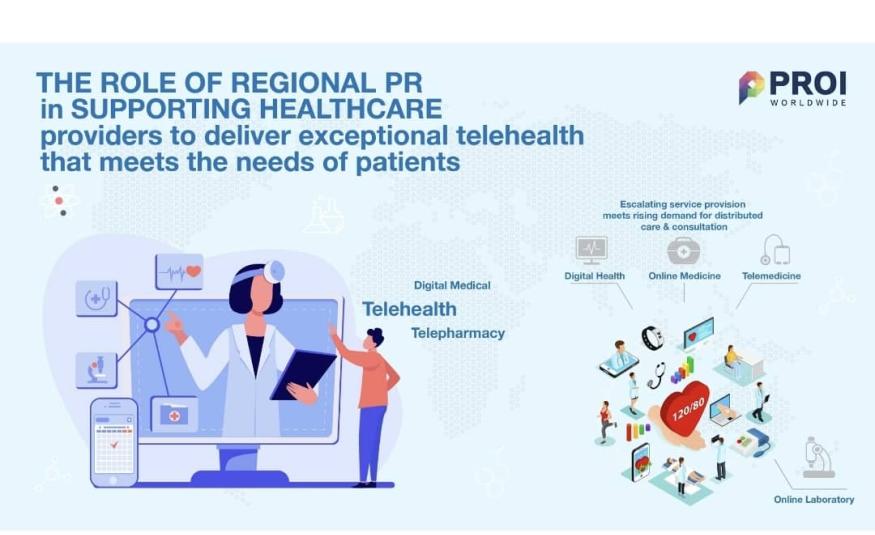The role of regional PR in supporting healthcare providers to deliver exceptional telehealth that meets the needs of patients
By: PROI Worldwide
MORE than ever before, healthcare businesses face numerous challenges as they seek to provide customers with a high level of care whilst ensuring their operations stay profitable. Providers need a way to communicate medical advances and improvements to services whilst managing growing demand from patients.
So, how can the healthcare industry, with its increasing focus on telemedicine, communicate the importance for app-based services that meet legislative and policy requirements, and at the same time, align with government-driven incentivized development and e-insurance services? Moreover, how can it be done in a way that ensures customers are familiar with what’s being offered and understand how best to take advantage of these innovations?
Escalating service provision meets rising demand for distributed care & consultation
In Bain’s 2019 Asia-Pacific Front Line of Healthcare survey, nearly 50% of patients said that they expect to use digital health tools in the next five years. Meanwhile, 91% of consumers said they would use digital health services if the costs were covered by an employer or insurance provider. This survey was conducted before the operational impact of COVID forced the industry to adapt to remote delivery of patient services.
It’s estimated the global telehealth market will reach USD$19.5 billion by 2025. Digital health platforms in Singapore, Indonesia and Australia are reporting a surge of activity, too. At MyDoc, a telemedicine platform headquartered in Singapore, the number of daily active users rose 60% in February and more than doubled again in March.
Insurer AXA Asia announced it is offering free teleconsultations to approximately 6.5 million people in Asia. The region is playing a key role, with world-leading medical facilities such as Bumrungrad in Thailand introducing an international consulting service for patients in response to limitations placed on its core business of medical tourism hospitality.
In Taiwan, the government has permitted Telehealth for remote areas in 2021. The National Health Insurance Division’s goal is to gradually improve the operating model, and then to expand the benefit range, allowing local departments to seek remote medical centers for cooperation and to define appropriate treatment and prescription.
Telehealth has also grown rapidly in Indonesia during the pandemic. Many companies provide holistic telemedicine via smartphone apps that bring more accessible healthcare services for Indonesian families. Subsequently, there has been a growing number of affiliations between Indonesia’s e-medicine platforms, like HaloDoc and Gojek (an on-demand multi-service platform and digital payment technology) and Good Doctor with Grab.
Similarly, Malaysia has experienced a surge in the growth of telehealth/telemedicine in the country after several lockdown measures were put in place to flatten the curve. Doctors can now connect with patients effectively via virtual care and in a much shorter time frame, minimizing the number of people in the hospitals. There is belief in the industry that Telehealth will continue to find more ways of expanding and improving, even paving the way for expansions in specialist channel provision such as for telepharmacy and dispensing separation.
The future for telehealth is bright. As a result of this, a more connected future will emerge that delivers better customer experiences, more valuable insights, and more effective provision of patient care.
Challenges in regulatory compliance, data protection, and adapting to this fast-changing world
Beyond the ability to scale the operational bandwidth of platforms to serve patient needs, the telehealth industry is facing challenges on the regulation side. As current regulation has not yet been reorientated enough to protect the health-tech ecosystem – largely a result of massive changes through Covid forcing a need to adapt almost overnight - there is increasing focus on the importance of communication aspects.
This means global players, new entrants and even current existing players in the industry will need the strategic support of an experienced partner in navigating the complexity of these issues with solid insights on how to effectively reach potential customers. Apart from meeting growing demand for services, there is massive competition, so providers need to be able to conduct advocacy activities to get buy-in from relevant stakeholders and achieve strong benefit communication.
Information security and personal privacy are also key issues. In Europe, the distribution of patient data among digital services seeking greater interconnection and access has already raised alarm bells. Disputes that may be increased as a result of the increased prominence of telehealth services represents a risk gap. At this stage, the infrastructure needs of hospitals, such as for system integration/data migration and information security are very strong.
The increasing need to be able to support patients with chronic diseases, the demand for mental health treatments and so forth indicate huge potential in Telehealth, but operators must be able to deliver whilst responding to newly shifting regulatory frameworks; and this is doubly complicated for international care providers responding to local implications whilst adapting to the potential of newly integrated digital platforms.
Together with PROI Worldwide healthcare communicators, PR firms which represent reputable players in the sector have been learning alongside industry experts and helping them navigate and communicate complex health issues and technology solutions for the healthcare industry.
PR firms help telehealth adoption by increasing visibility and positive publicity, building and maintaining the great reputation of the provider, introducing campaigns and responding to macro happenings which prompt public concern and a desire for change.
Social media, webinars, media engagement, influencer & content marketing, and traditional tactical implementation all support a wider program of strategic awareness-building, thereby furthering the societally positive agenda of the sector’s growth area in respect of telehealth. Therefore, beyond simply growing publicity, agencies empower organizations to help them connect with their communities.
It isn’t just about publicity. It is about helping organizations connect with their community and champion for change. Standing out in the competitive healthcare landscape and building a trusted brand reputation requires consistent, strategic, effective public relations and careful communications of the key patient benefits for Telehealth. - DagangNews.com










